
WESTERN Victoria’s green, rolling lands look a picture of tranquillity, but 180 years or so ago they were bloody battlegrounds of wars between native Aborigines and white settlers.
Subscribe now for unlimited access.
or signup to continue reading
From when the first sealers and whalers arrived just after the turn of the century to at least 1847, hundreds, if not thousands of the original inhabitants were killed.
It was a time of bitter conflict as the European settlers brought in tens of thousands of sheep and cattle onto the Aborigines’ territory and confiscated their water sources.
Hunting raids by Aborigines to steal or chase away the livestock triggered increasing violence and for every European killed by raiding natives there were revenge attacks sometime better described as massacres.
According to some historians there was an unofficial revenge ratio of at least 20 Aborigines for every white death.
The state’s Protector of Aborigines George Robinson wrote in one of his many diaries the retaliation between natives and Europeans west of the Grampians was 40 blacks to one white but reports from Aboriginal survivors suggested that figure could be trebled.
Many of today’s towns and districts and forefathers of respected families are mentioned in records of massacres.
Warrnambool Aboriginal elder Robert Lowe has walked the boundary of his traditional Maar nation twice, the most recent this year, to honour his ancestors.
He presented a message stick to Warrnambool City mayor Jacinta Ermacora this week to mark a significant chapter of the district’s history when bloodshed decimated Aboriginal tribes.
A month earlier he attended the official unveiling of a memorial stone at Port Fairy to recall massacres in that district.
Former Warrnambool-based Deakin University lecturer Jan Critchett has written extensively on how early European settlement dramatically changed the region within three decades.
Her books refer to various observations by settlers, government officials and natives painting a bitter struggle between two vastly-different cultures.
Early white explorers estimated there were once about 600 tribes and more than 200 languages scattered across the Western District.
Aborigines lived in permanent huts and had elaborate fishing and food gathering methods, but with the invasion of pastoralists they took on a more nomadic lifestyle.
Perhaps the most infamous massacre was at Narrawong on what is now known as The Convincing Ground, referred to by Portland pioneer Edward Henty.
It involved whalers who clashed with Aborigines over a beached whale.
Robinson noted that Henty recalled the enraged whalers “let fly right and left upon the natives”.
The incident was regarded as the first stand by Aborigines to assert their rights and European arms won the day.
Critchett says it was a pattern repeated across the district: “the need to convince the Aborigines not to steal European property”.
“In some cases the total adult male population of an Aboriginal group was massacred in one confrontation. And in many cases native women were the cause of conflict between the races.”
Hunting parties became relatively commonplace, where groups of heavily-armed white men would ambush Aborigines.
One account mentions 13 hunting parties organised around Dunmore-Yambuk between 1845 and 1847.
At Mount Napier more than 30 Aborigines were “laid low” while eating breakfast.
One reference in Critchett’s A Distant Field of Murder refers to Captain Campbell, of Port Fairy, who said the lives of 20 Aborigines should be taken for the death of a local man Patrick Codd.
She writes “the district was in turmoil by August 1842.
There was a limit to how much settlers could be expected to tolerate without retaliation and according to the Portland Mercury it had been reached”.
Author Rolf Boldrewood refers to the Eumeralla War in 1842 near Mount Eccles when Aborigines used guerilla tactics to wreak havoc on settlers.
One notable massacre was attributed to the Whyte brothers at Wannon when nine armed men killed up to 50 Aborigines as retaliation for stealing and killing 50 sheep.
An observer wrote: “the bones of the men and the sheep lay mingled together bleaching in the sun at the Fighting Hills”.
Noorat district settler Niel Black noted there was bragging about killings which were carried out mostly by “settlers scarcely less savage tho more enlightened than themselves”.
Robinson wrote that much of the violence towards Aborigines came from ex-convicts who “considered the life of a native to be of no more value than a wild dog”.
Crichett says it is impossible to know how many Aborigines were killed and never reported.
“The bragging and boasting about killing Aborigines referred to by Black is one factor encouraging the view that large numbers of Aborigines were killed.”














